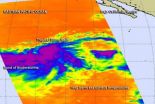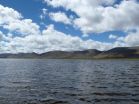(Press-News.org) Tropical Storm Iselle was born in the Eastern Pacific Ocean soon after NASA's Aqua satellite gathered infrared imagery on the storm that showed powerful thunderstorms wrapping into developing storm's center. Iselle is not close enough to land to cause any watches or warnings.
The Atmospheric Infrared Sounder or AIRS instrument aboard NASA's Aqua satellite passed over System 95E on July 31 at 5:23 p.m. EDT from gathered infrared data before it became Tropical Storm Iselle. The data was made into a false-colored image at NASA's Jet Propulsion Laboratory in Pasadena, California. The AIRS data showed a large band of powerful thunderstorms west of Iselle's center wrapping into the storm. The thunderstorms had cloud top temperatures as cold as -63F/-52C indicating the cloud tops were near the top of the troposphere.
National Hurricane Center forecaster Blake noted in an August 1 discussion "A recent AMSU microwave pass also suggests that the inner core has become better defined, with perhaps a partial eyewall in the eastern semicircle." Advanced microwave sounding unit (AMSU) is a multi-channel microwave radiometer installed on meteorological satellites, including NASA's Aqua satellite that carries the AIRS instrument.
Tropical storm Iselle was born on July 31 at 2100 UTC (5 p.m. EDT). On August 1, Iselle's maximum sustained winds were already up to 60 mph (95 kph). At 5 a.m. EDT (2 a.m. PDT/0900 UTC).the center of Tropical Storm Iselle was located near latitude 13.5 north and longitude 124.6 west. Iselle is centered about 1,160 miles (1,870 km) west-southwest of the southern tip of Baja California, Mexico.
Iselle was moving toward the west-northwest near 10 mph (17 kph) and is expected to continue moving in that direction over the next couple of days.
Satellite data indicate that tropical storm force winds extend outward up to 105 miles (165 km) from the center, making the storm about 210 miles in diameter.
NHC noted that environmental conditions appear conducive for further strengthening over the next couple of days. Those conditions include light-to-moderate northeasterly shear and warm water.
The National Hurricane Center (NHC) expects Iselle to reach hurricane status by August 2.
INFORMATION:
Text credit: Rob Gutro
NASA's Goddard Space Flight Center
NASA eyes powerful bands of thunderstorms in newborn Tropical Storm Iselle
2014-08-01
ELSE PRESS RELEASES FROM THIS DATE:
Heavy metals and hydroelectricity
2014-08-01
Boulder, Colorado, USA – Hydraulic engineering is increasingly relied on for hydroelectricity generation. However, redirecting stream flow can yield unintended consequences. In the August 2014 issue of GSA Today, Donald Rodbell of Union College-Schenectady and coauthors from the U.S. and Peru document the wholesale contamination of the Lake Junín National Reserve by acid mine drainage from the Cerro de Pasco mining district.
According to the World Bank, about 60% of Peru's electricity is generated by hydropower, which during the dry season relies heavily on glacial meltwater ...
Scripps Research Institute scientists find new calorie-burning switch in brown fat
2014-08-01
LA JOLLA, CA—August 1, 2014—Biologists at The Scripps Research Institute (TSRI) have identified a signaling pathway that switches on a powerful calorie-burning process in brown fat cells.
The study, which is reported in this week's online Early Edition of the Proceedings of the National Academy of Sciences, sheds light on a process known as "brown fat thermogenesis," which is of great interest to medical researchers because it naturally stimulates weight loss and may also protect against diabetes.
"This finding offers new possibilities for the therapeutic activation ...
New mothers still excessively sleepy after 4 months: QUT study
2014-08-01
New mums are being urged to be cautious about returning to work too quickly, after a QUT study found one in two were still excessively sleepy four months after giving birth.
Dr Ashleigh Filtness, from QUT's Centre for Accident Research & Road Safety - Queensland (CARRS-Q), studied the sleep patterns and tiredness of postpartum mums and found despite new mums recording stable night sleep times at 18 weeks, they continued to report being excessively tired.
The CARRS-Q study, published in PLOS ONE, followed 33 healthy new mums who recorded their postpartum sleep patterns ...
Effect of microenvironment modulation on stem cell therapy for spinal cord injury pain
2014-08-01
Spinal cord injury (SCI) currently ranks second after mental retardation among neurological disorders in terms of cost to society. Pain is a debilitating consequence of SCI related to the nature of the lesion, neurological structures damaged, and secondary pathophysiological changes of surviving tissues1. Approximately two-thirds of persons who have sustained SCI experience clinically significant pain after injury, of whom one-third have severe pain2, 3. Post-SCI pain can increase with time and is often refractory to conventional treatment approaches4. Over the past decade, ...
Acrolein as a novel therapeutic target for motor and sensory deficits in spinal cord injury
2014-08-01
Acrolein, a highly reactive unsaturated aldehyde, has been shown to play a major role in the secondary injury by contributing significantly to both motor and sensory deficits. Prof. Riyi Shi, who comes from University of Purdue in USA will highlight the recent developments in the understanding of the mechanisms of acrolein in motor and sensory dysfunction in animal models of spinal cord injury, and will also discuss the therapeutic benefits of using acrolein scavengers to attenuate acrolein-mediated neuronal damage following spinal cord injury. The relevant study has been ...
Recent advances in stem cell biology
2014-08-01
Advances in stem cell research will provide enormous opportunities for both biological and future clinical applications. Basically, stem cells could replicate any other cells in the body, offering immense hope of curing Alzheimer's disease, repairing damaged spinal cords, treating kidney, liver and lung diseases and making damaged hearts whole. The potential for profit is staggering. Prof. Jinhui Chen from Indiana University in USA considered that this field of research still faces myriad biological, ethical, legal, political, and financial challenges. The eventual resolution ...
Developmental regulation of important plant phloem components discovered
2014-08-01
Sieve elements are a key component of phloem, the conductive tissue through which plants transport carbohydrates and a wide range of signalling molecules. Elongated cylindrical cells are capped at one end by a sieve plate and arranged end-to-end to form sieve tubes which in turn form a network throughout a plant's body.
"Sieve elements are very special cells which play an important role in carbon sequestration, yet so far very little has been known about their differentiation," says Professor Ykä Helariutta from the Institute of Biotechnology, University of Helsinki, ...
Plastic surgeons or nurses: Who are the better injectors?
2014-08-01
In recent years, minimally invasive aesthetic injectable procedures have grown in popularity as more and more men and women are seeking age-defying treatments. As Botulinum toxin – generally known as BOTOX® – use has increased, a growing number of nonaesthetic health professionals have emerged to perform procedures utilizing this and other injectables. Kevin Small, MD and Henry M. Spinelli, MD from the Division of Plastic Surgery Presbyterian Hospital in New York and Kathleen M. Kelly, MD from Columbia University in New York have assessed the capability of various providers ...
'Active' surfaces control what's on them
2014-08-01
CAMBRIDGE, Mass-- Researchers at MIT and in Saudi Arabia have developed a new way of making surfaces that can actively control how fluids or particles move across them. The work might enable new kinds of biomedical or microfluidic devices, or solar panels that could automatically clean themselves of dust and grit.
"Most surfaces are passive," says Kripa Varanasi, an associate professor of mechanical engineering at MIT, and senior author of a paper describing the new system in the journal Applied Physics Letters. "They rely on gravity, or other forces, to move fluids or ...
'Wetting' a battery's appetite for renewable energy storage
2014-08-01
RICHLAND, Wash. – Sun, wind and other renewable energy sources could make up a larger portion of the electricity America consumes if better batteries could be built to store the intermittent energy for cloudy, windless days. Now a new material could allow more utilities to store large amounts of renewable energy and make the nation's power system more reliable and resilient.
A paper published today in Nature Communications describes an electrode made of a liquid metal alloy that enables sodium-beta batteries to operate at significantly lower temperatures. The new electrode ...



